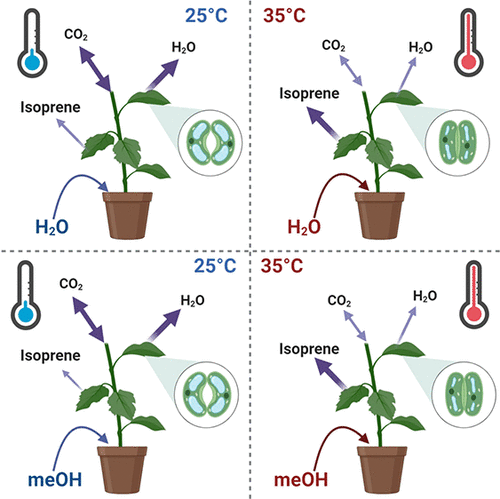当前位置:
X-MOL 学术
›
ACS Earth Space Chem.
›
论文详情
Our official English website, www.x-mol.net, welcomes your
feedback! (Note: you will need to create a separate account there.)
High Temperature Acclimation of Leaf Gas Exchange, Photochemistry, and Metabolomic Profiles in Populus trichocarpa
ACS Earth and Space Chemistry ( IF 2.9 ) Pub Date : 2021-08-03 , DOI: 10.1021/acsearthspacechem.0c00299 Rebecca A. Dewhirst 1 , Pubudu Handakumbura 2 , Chaevien S. Clendinen 2 , Eva Arm 2 , Kylee Tate 2 , Wenzhi Wang 3 , Nancy M. Washton 2 , Robert P. Young 2 , Jenny C. Mortimer 4, 5 , Nate G. McDowell 3, 6 , Kolby J. Jardine 1
ACS Earth and Space Chemistry ( IF 2.9 ) Pub Date : 2021-08-03 , DOI: 10.1021/acsearthspacechem.0c00299 Rebecca A. Dewhirst 1 , Pubudu Handakumbura 2 , Chaevien S. Clendinen 2 , Eva Arm 2 , Kylee Tate 2 , Wenzhi Wang 3 , Nancy M. Washton 2 , Robert P. Young 2 , Jenny C. Mortimer 4, 5 , Nate G. McDowell 3, 6 , Kolby J. Jardine 1
Affiliation

|
High temperatures alter the thermal sensitivities of numerous physiological and biochemical processes that impact tree growth and productivity. Foliar and root applications of methanol have been implicated in plant acclimation to high temperature via the C1 pathway. Here, we characterized temperature acclimation at 35 °C of leaf gas exchange, chlorophyll fluorescence, and extractable metabolites of potted Populus trichocarpa saplings and examined potential influences of mM concentrations of methanol added during soil watering over a two-month period. Relative to plants grown under the low growth temperature (LGT), high growth temperature (HGT) plants showed a suppression of leaf water use and carbon cycling including transpiration (E), net photosynthesis (Pn), an estimate of photorespiration (Rp), and dark respiration (Rd), attributed to reductions in stomatal conductance and direct negative effects on gas exchange and photosynthetic machinery. In contrast, HGT plants showed an upregulation of nonphotochemical quenching (NPQt), the optimum temperature for ETR, and leaf isoprene emissions at 40 °C. A large number of metabolites (867) were induced under HGT, many implicated in flavonoid biosynthesis highlighting a potentially protective role for these compounds. Methanol application did not significantly alter leaf gas exchange but slightly reduced the suppression of Rd and Rp by the high growth temperature while slightly impairing ETR, Fv′/Fm′, and qp. However, we were unable to determine if soil methanol was sufficiently taken up by the plant to have a direct effect on foliar processes. A small number of extracted leaf tissue metabolites (55 out of 10 015) showed significantly altered abundances under LGT and methanol treatments relative to water controls, and this increased in compound number (222) at the HGT. The results demonstrate the large physiological and biochemical impacts of high growth temperature on poplar seedlings and highlight the enhancement of the optimum temperature of ETR as a rapid thermal acclimation mechanism. Although no large effect on leaf physiology was observed, the results are consistent with methanol both impairing photochemistry of the light reactions via formaldehyde toxicity and stimulating photosynthesis and dark respiration through formate oxidation to CO2.
中文翻译:

毛果杨叶片气体交换、光化学和代谢组学特征的高温驯化
高温会改变影响树木生长和生产力的众多生理和生化过程的热敏感性。甲醇的叶面和根部应用与植物通过 C 1途径适应高温有关。在这里,我们表征了 35 °C 下的叶气体交换、叶绿素荧光和盆栽毛果杨树苗的可提取代谢物的温度驯化,并检查了两个月期间土壤浇水期间添加的 mM 甲醇浓度的潜在影响。相对于在低生长温度 (LGT) 下生长的植物,高生长温度 (HGT) 植物表现出对叶片水分利用和碳循环的抑制,包括蒸腾作用 (E)、净光合作用 ( P n),光呼吸 ( R p ) 和暗呼吸 ( R d )的估计值,归因于气孔导度的降低以及对气体交换和光合机械的直接负面影响。相比之下,HGT 植物表现出非光化学淬灭 (NPQ t )、ETR 的最佳温度和 40 °C 时叶片异戊二烯排放的上调。在 HGT 下诱导了大量代谢物 (867),其中许多与类黄酮生物合成有关,突出了这些化合物的潜在保护作用。施用甲醇没有显着改变叶片气体交换,但略微降低了对R d和R p的抑制受高生长温度的影响,同时略微损害 ETR、Fv'/Fm' 和q p. 然而,我们无法确定土壤甲醇是否被植物充分吸收以对叶面过程产生直接影响。与水对照相比,在 LGT 和甲醇处理下,少量提取的叶组织代谢物(10 015 个中的 55 个)显示出显着改变的丰度,并且这在 HGT 中增加了化合物数量 (222)。结果证明了高生长温度对杨树幼苗的巨大生理和生化影响,并突出了 ETR 最适温度的提高作为快速热驯化机制。虽然没有观察到对叶片生理学产生大的影响,但结果与甲醇通过甲醛毒性损害光反应的光化学和通过甲酸氧化成 CO 刺激光合作用和暗呼吸一致2 .
更新日期:2021-08-19
中文翻译:

毛果杨叶片气体交换、光化学和代谢组学特征的高温驯化
高温会改变影响树木生长和生产力的众多生理和生化过程的热敏感性。甲醇的叶面和根部应用与植物通过 C 1途径适应高温有关。在这里,我们表征了 35 °C 下的叶气体交换、叶绿素荧光和盆栽毛果杨树苗的可提取代谢物的温度驯化,并检查了两个月期间土壤浇水期间添加的 mM 甲醇浓度的潜在影响。相对于在低生长温度 (LGT) 下生长的植物,高生长温度 (HGT) 植物表现出对叶片水分利用和碳循环的抑制,包括蒸腾作用 (E)、净光合作用 ( P n),光呼吸 ( R p ) 和暗呼吸 ( R d )的估计值,归因于气孔导度的降低以及对气体交换和光合机械的直接负面影响。相比之下,HGT 植物表现出非光化学淬灭 (NPQ t )、ETR 的最佳温度和 40 °C 时叶片异戊二烯排放的上调。在 HGT 下诱导了大量代谢物 (867),其中许多与类黄酮生物合成有关,突出了这些化合物的潜在保护作用。施用甲醇没有显着改变叶片气体交换,但略微降低了对R d和R p的抑制受高生长温度的影响,同时略微损害 ETR、Fv'/Fm' 和q p. 然而,我们无法确定土壤甲醇是否被植物充分吸收以对叶面过程产生直接影响。与水对照相比,在 LGT 和甲醇处理下,少量提取的叶组织代谢物(10 015 个中的 55 个)显示出显着改变的丰度,并且这在 HGT 中增加了化合物数量 (222)。结果证明了高生长温度对杨树幼苗的巨大生理和生化影响,并突出了 ETR 最适温度的提高作为快速热驯化机制。虽然没有观察到对叶片生理学产生大的影响,但结果与甲醇通过甲醛毒性损害光反应的光化学和通过甲酸氧化成 CO 刺激光合作用和暗呼吸一致2 .











































 京公网安备 11010802027423号
京公网安备 11010802027423号